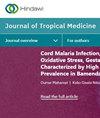显微镜、SD-Bioline 快速诊断测试和聚合酶链式反应在检测喀麦隆西南地区昆巴卫生区孕妇分娩时感染疟疾方面的诊断性能比较
IF 2.5
4区 医学
Q3 PUBLIC, ENVIRONMENTAL & OCCUPATIONAL HEALTH
引用次数: 0
摘要
导言。妊娠期疟疾是撒哈拉以南非洲地区发病和死亡的主要原因。世界卫生组织推荐用于临床诊断的显微镜检查和快速诊断检测(RDT)的灵敏度较低,无法检测出寄生虫血症水平很低的个体。以往的研究表明,妊娠期疟疾与乳腺炎和分娩时子宫失血过多有关。然而,在全国范围内评估这些工具在检测妊娠期疟疾方面性能的信息非常有限。因此,本研究评估了显微镜、RDT 和巢式聚合酶链反应(nPCR)在检测分娩时与妊娠有关的疟疾方面的性能。研究方法从昆巴卫生区内的五家医疗机构共招募了 227 名参与者,其中包括 201 名未感染艾滋病毒的孕妇和 26 名感染艾滋病毒的孕妇。在分娩时采集母体静脉血和脐带血,使用厚膜显微镜、SD-bioline RDT 和 18SrRNA 嵌套 PCR 检测疟疾。结果显示通过厚膜显微镜(TFM)、RDT 和 PCR 检测,感染和未感染 HIV 的孕妇中疟疾阳性病例的比例分别为 7.69%、53.85% 和 50%,以及 3.48%、23.38% 和 49.25%。在未感染艾滋病毒的妇女的脐带血样本中,通过 PCR 检测出恶性疟原虫的比例为 1.99%。至少两种检测方法的阳性率(复合阳性)分别为:感染 HIV 的妇女 42.31%,未感染 HIV 的妇女 19.90%。在所有样本中,以 PCR 作为参考的 TFM 和 RDT 的灵敏度分别为 7.21% 和 49.00%。特异性分别为 99.14% 和 90.55%,卡帕值分别为 0.064 和 0.461。以综合检测作为参考,TFM、RDT 和 nPCR 的灵敏度分别为 15.69%、94.12% 和 100%。特异性分别为 99.43%、93.18% 和 65.34%,卡帕值分别为 0.213、0.821 和 0.458。结论这项研究表明,在检测疟原虫方面,PCR 的灵敏度高于 SD-bioline RDT 试剂盒。然而,在资源有限的环境中,疟疾的分子诊断难以获得,因此应考虑将 RDT 作为疟疾诊断中显微镜检查的首选。本文章由计算机程序翻译,如有差异,请以英文原文为准。
Comparative Diagnostic Performance of Microscopy, SD-Bioline Rapid Diagnostic Test, and Polymerase Chain Reaction in the Detection of Malaria Infection among Pregnant Women at Delivery in Kumba Health District Area in the Southwest Region of Cameroon
Introduction. Malaria during pregnancy is a major cause of morbidity and mortality in sub-Saharan Africa. Microcopy and rapid diagnostic test (RDT) recommended by the World Health Organization for clinical diagnosis have poor sensitivity to detect individuals with very low levels of parasitemia. Previous studies have shown that malaria in pregnancy is associated with mastitis and excessive uterine blood loss during delivery. However, information evaluating the performance of these tools in detecting malaria in pregnancy at the national level is limited. This study therefore evaluates the performance of microscopy, RDT, and nested polymerase chain reaction (nPCR) in the detection of pregnancy-associated malaria at delivery. Methods. A total of 227 participants constituting of 201 pregnant women without and 26 with HIV were recruited from five health facilities within the Kumba health district area. Mother venous and cord blood were collected at delivery to test for malaria using the thick-film microscopy, SD-bioline RDT, and 18SrRNA-nested PCR. Results. The percentage of malaria-positive cases detected by thick-film microcopy (TFM), RDT, and PCR in pregnant women with and without HIV was 7.69%, 53.85%, and 50% and 3.48%, 23.38%, and 49.25%, respectively. Plasmodium falciparum was detected in 1.99% cord blood samples of women without HIV by PCR. The positivity rate in at least two of the test methods (composite positive) was 42.31% for women with and 19.90% for women without HIV. The sensitivity of TFM and RDT when using PCR as a reference was 7.21% and 49.00%, respectively, in all samples. The specificity was 99.14% and 90.55% with kappa values of 0.064 and 0.461, respectively. When using the composite test as a reference, the sensitivity of TFM, RDT, and nPCR was 15.69%, 94.12%, and 100%, respectively. Specificity was 99.43%, 93.18%, and 65.34% with kappa values of 0.213, 0.821, and 0.458, respectively. Conclusion. This study shows that PCR is more sensitive in the detection of malaria parasite followed by SD-bioline RDT kit. However, in resource-limited settings where access to molecular diagnosis of malaria is a problem, RDT should be considered as the first option to microscopy in the diagnosis of malaria.
求助全文
通过发布文献求助,成功后即可免费获取论文全文。
去求助
来源期刊

Journal of Tropical Medicine
Immunology and Microbiology-Parasitology
CiteScore
3.90
自引率
4.50%
发文量
0
审稿时长
14 weeks
期刊介绍:
Journal of Tropical Medicine is a peer-reviewed, Open Access journal that publishes original research articles, review articles, and clinical studies on all aspects of tropical diseases. Articles on the pathology, diagnosis, and treatment of tropical diseases, parasites and their hosts, epidemiology, and public health issues will be considered. Journal of Tropical Medicine aims to facilitate the communication of advances addressing global health and mortality relating to tropical diseases.
 求助内容:
求助内容: 应助结果提醒方式:
应助结果提醒方式:


